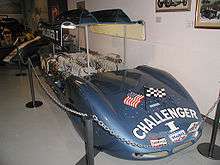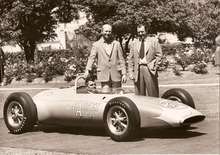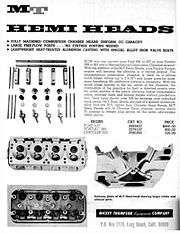Mickey Thompson
| Mickey Thompson | |||
|---|---|---|---|
| Born |
Marion Lee Thompson December 7, 1928 Alhambra, California | ||
| Died |
March 16, 1988 (aged 59) Bradbury, California | ||
| Cause of death | Murder by gunshot | ||
| Nationality |
| ||
| Occupation | Race car driver | ||
| Known for | First American to break the 400 mph barrier | ||
| Spouse(s) | Trudy Thompson | ||
| Children |
| ||

Marion Lee "Mickey" Thompson (December 7, 1928 – March 16, 1988) was an American off-road racing celebrity.
A hot rodder since his youth, Thompson increasingly pursued land speed records in his late 20s and early 30s.[1] He achieved international fame in 1960 when he became the first American to break the 400 mph barrier, driving his Challenger 1 to a one-way top speed of 406.60 mph at the Bonneville Salt Flats and surpassing John Cobb's one-way world record mark of 402 mph.
Thompson then turned to racing, winning many track and dragster championships. Later he formed sanctioning bodies SCORE International and Mickey Thompson Entertainment Group (MTEG).
In 1988 Thompson and his wife Trudy were mysteriously gunned down at their home in Bradbury, California. The crime remained unsolved until 2007, when a former business partner was convicted of having orchestrated the murders.[2]
Early history
Thompson was born in Alhambra, California. In his early twenties, he worked as a pressman[1] for the Los Angeles Times newspaper while pursuing a lifelong love of Hot rodding. He later became involved in the new sport of drag racing. Tireless and innovative, he found success both as a championship driver and an instinctive automotive technician.
Over the course of his career Thompson set more speed and endurance records than any other man in automotive history. He is credited with designing and building the first slingshot dragster, in 1954, moving the seat behind the rear axle to improve traction when existing racing tires proved unable to handle the output of increasingly powerful custom engines.[3] A change so momentous would not happen again until Don Garlits introduced the rear-engined digger in 1971.[4] Thompson also was noted for being the first manager of Lions Drag Strip in Wilmington, California, in 1955.
Determined to set a new land speed record[1] Thompson achieved international fame[5] when he drove his four-engined Challenger 1 past 400 mph in 1960 at the Bonneville Salt Flats, becoming the first American to break that barrier and setting a new one-way mark of 406.60 mph, surpassing John Cobb's one-way high of 402 mph.
Indy years
1962

In 1962 Thompson entered three John Crosthwaite designed cars in the Indianapolis 500. Unusually, they used a stock V8 Buick engine and it was in the rear unlike the front engined, race tuned, Offenhauser powered cars used by most competitors. It was the first stock engine to be raced at Indy since 1946. Thompson's crew, led by Fritz Voigt, were young, smart and hard working. Working 12-14 hour days, the car was designed and built in 120 days. For the race, the engine (enlarged to 4.2 litre capacity, the maximum allowed by the regulations for “stock block” engines) had to be detuned because they were concerned it would not last the distance. Despite being more than 70 bhp down on the other cars, Dan Gurney qualified eighth and was in ninth place until a leaking oil seal seized the gearbox and ended his race on lap 94. He was placed 20th out of 33. The team won the Mechanical Achievement Award for original design, construction and accomplishment.[6][7]
1963
Thompson's promotion skills pleased the sponsors with the publicity generated that year. For the 1963 Indianapolis 500 Crosthwaite designed the innovative Harvey Aluminium Special "roller skate car" with the then pioneering smaller profile (12 inch diameter) and wide racing tires (front 7 inches and rear 9 inches wide) and wheels. Thompson took five cars to Indianapolis. Two of the previous year's design with Chevrolet V8 engines and three roller skate cars. One of the new cars, the Harvey Titanium Special, featured a lightweight titanium chassis. Al Miller II raced one of the modified 1962 cars to ninth place despite only qualifying in 31st position. Duane Carter qualified one of the roller skate cars 15th but was only placed 23rd after an engine failure on the 100th lap. The small tire sizes and low car weights caused complaints amongst the old hands and owners, so for future races, cars were restricted to minimum tire sizes and minimum car weights.[8][9]
1962 Formula One World Champion Graham Hill tested one of the roller skate cars at Indianapolis in 1963, but refused to race it citing its poor handling.
In 1963 Thompson traveled to England where, along with Dante Duce, he demonstrated his Ford-powered top fuel Harvey Aluminum Special dragster at the Brighton Speed Trials. It was then displayed at the Racing Car Show in London in January 1964.[10]
1964
Thompson brought three modified 12-inch tire cars to the 1964 Indianapolis 500, but new rules required him to use 15-inch tires. The Allstate sponsored team used Allstate tires and Ford engines. The chassis had to be altered to accommodate the larger Ford engines. Two of them qualified for the race. The car No.84 began the month with Masten Gregory as the driver but Eddie Johnson in car No.84 qualified 24th and finished 26th. Dave MacDonald in car No.83 qualified 14th and died in a fiery crash on the second lap.
1965–1968
Thompson went back to Indy in 1965 but failed to qualify in an attempt with a front engine roadster. He skipped 1966 but tried again in 1967 and 1968, again failing to qualify either year.[11] The 1967 attempt used a unique all wheel drive rear engine design that steered both front and rear wheels, but Gary Congdon was unable to qualify any of the three cars.[12][13]
Post Indy

In 1965 Thompson published "Challenger: Mickey Thompson's own story of his life of speed." In 1968, he redesigned the funny car, and went on to win the 1969 NHRA Spring Nationals and NHRA Nationals with driver Danny Ongais. In his long career, Thompson raced everything from stock cars to off-road vehicles and engineered numerous competition engines. He went into the performance aftermarket business in the early 1960s and then, in 1963, he created "Mickey Thompson Performance Tires" that developed special tires for racing including for Indianapolis 500 competitors.
Thompson founded SCORE International in 1973, a sanctioning body to oversee off-road racing across North America. He and his wife Trudy formed the "Mickey Thompson Entertainment Group" (MTEG) which ran an indoor motocross and off-road vehicle racing show and competition that brought the sport from the back-country to major metropolitan stadiums and arenas.
Murder

On March 16, 1988, Thompson and his wife Trudy were killed by two hooded gunmen outside their home in Bradbury, California in the foothills of the San Gabriel Mountains.[2]
On the morning of the murder a pair of unknown assailants waited outside the Thompson home for the couple to leave for the day. Mickey opened the garage door for his wife to pull out in her vehicle, and as he headed for his own car the gunmen attacked. He was shot and wounded, then dragged out into the driveway while one of the attackers went after Trudy as she backed out. Killing her, the gunman then came back up the driveway where the other gunman was watching over Mickey and shot him fatally in the head.[2] The attackers then made their escape on the bicycles they had ridden to the Thompson residence.
An intense police investigation failed to uncover either the identity of the mystery gunmen, or a motive for the crime. It remained a dead-end until 2001, when former Thompson business partner Michael Frank Goodwin was charged in Orange County, California with the murders.[2] Before a trial could be completed that case was overturned on jurisdictional grounds by the California District Court of Appeal. On June 8, 2004, Goodwin was formally charged with the murders in Pasadena in Los Angeles County. In October 2006, a Pasadena Superior Court judge ordered Goodwin to stand trial.[2]
On January 4, 2007, a jury found the accused guilty of two counts of murder in the death of Thompson and his wife. Goodwin was sentenced to two consecutive life-without-parole terms. A subsequent motion for a new trial was denied.[2]
The murder investigation was the subject of an episode of NBC's Unsolved Mysteries and Investigation Discovery's Murder Book. It was also the subject of the April 28, 2007 episode of the CBS television program 48 Hours Mystery. The 2004 CSI episode "Early Rollout" was based on this murder case. TV coverage, and its fictionalisation through CSI, were cited by the defense team in the murder trial as having created a "folklore" around the case, preventing a fair trial.[14]
Thompson, his wife and his pets are interred in the Rose Hills Memorial Park, in Whittier, California.
Awards
- Thompson was inducted posthumously to both the Motorsports Hall of Fame of America and the International Motorsports Hall of Fame in 1990.
- Thompson was ranked No. 11 on the National Hot Rod Association Top 50 Drivers, 1951–2000
- Thompson was inducted posthumously to the Automotive Hall of Fame in 2009.
See also
- Stadium Super Trucks, a racing series inspired by Thompson's stadium off-road racing
- Danny Thompson, Thompson's son, also a race car driver
References
- 1 2 3 "The Hottest Hot Rodder in the World." Popular Science, December 1959, pp. 95-98/218.
- 1 2 3 4 5 6 "Guilty verdict in Thompson murder case - latimes". Articles.latimes.com. 2007-01-05. Retrieved 2016-08-27.
- ↑ Hot Rod, 12/86, p.29 sidebar.
- ↑ Hot Rod, 12/86, p.28.
- ↑ "Gassing up with Mickey Thompson and the Challenger I streamliner | Hemmings Daily". Blog.hemmings.com. Retrieved 2016-08-27.
- ↑ Car and Driver magazine August 1962
- ↑ Motor Trend magazine June 1962, MotorSport magazine June 1962, Motor magazine August 1962, Mickey Thompson, Indianapolis 500 Mile Race USAC Yearbook 1962. Floyd Clymer, San Diego Union newspaper May 27th 1962, San Diego Union newspaper June 1st 1962, Los Angeles Times newspaper May 17th 1962, Los Angeles Times newspaper June 1st 1962, Road & Track magazine June 1962
- ↑ Hot Rod magazine May 1963
- ↑ Road & Track magazine June 1963, Motor Trend magazine June 1963, Car & Driver magazine June 1963, Car and Driver magazine August 1963, Bang Shift : Gallery : Mickey Thompson exhibit at the NHRA museum, Mickey Thompson - Indy 500 1963, Indianapolis 500 Mile Race USAC Yearbook 1963, Floyd Clymer
- ↑ See: The Observer, January 26, 1964, Page 19.
- ↑ Garner, Art, "Black Noon: The Year They Stopped the INDY 500", Page 316, Thomas Dunne Books, 2014.
- ↑ "Archived copy". Archived from the original on 2015-03-15. Retrieved 2014-08-03.
- ↑ "1967 Indianapolis 500". Racing-Reference.info. 1967-05-30. Retrieved 2016-08-27.
- ↑ "Goodwin Found Guilty In Mickey Thompson Murder Trial". NBC4 TV. January 4, 2007. Archived from the original on 2007-01-05.
External links
- News release on documentary of the murder
- Trial Commentary
- M/T Tires Official Page
- Michael Goodwin profile on America's Most Wanted